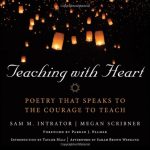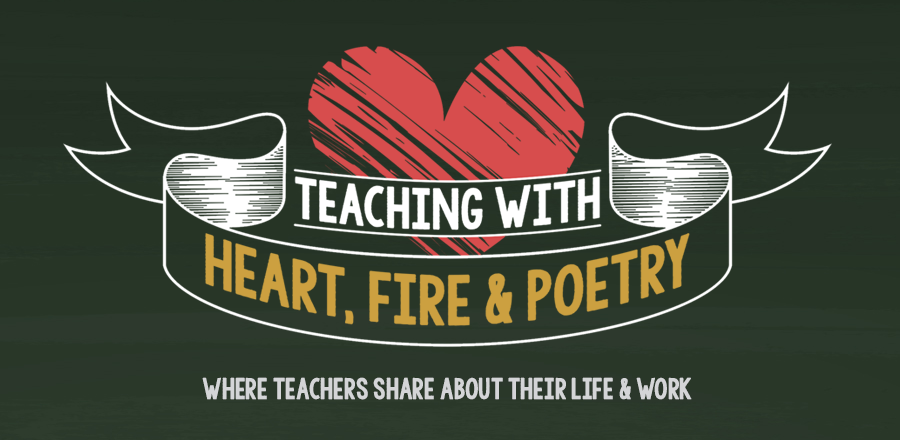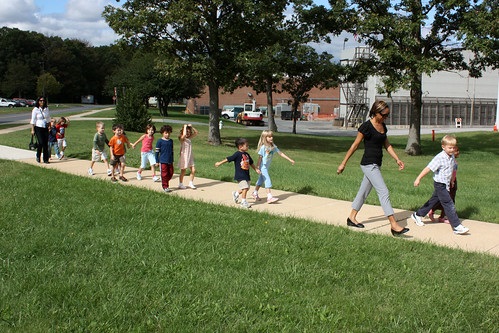 Tuesday, September 3rd, was the first day of school here. While waiting for the bus to work, I saw mothers and their children walking to the nearby elementary school. It brought back a rush of sweet memories. Though it has been years since my children were that young and it’s been many more years since I was in school, I still think of September as the beginning of the New Year.
Tuesday, September 3rd, was the first day of school here. While waiting for the bus to work, I saw mothers and their children walking to the nearby elementary school. It brought back a rush of sweet memories. Though it has been years since my children were that young and it’s been many more years since I was in school, I still think of September as the beginning of the New Year.
The period between the end of August and the beginning of the school year may only be a few days in time – but suddenly everything feels different. The days are cooler, the light is more subdued, and the greens of the trees seem deeper. Change is in the air!
Each September, I find myself buoyed by its potential and possibilities, energized with high expectations for what I’ll be able to do and accomplish in this new season, this New Year.
That’s one of the many reasons that Taylor Mali’s Introduction to our book, Teaching with Heart, struck such a chord with me. He captures the magic of this time – imminence.
In the Northeast, where I grew up, that time of year is a mixture of mown grass, cooler nights, and a smell I can only describe as imminence. Something about to start. As a student, I followed a yearly ritual to prepare for it: binders stocked full of loose-leaf; backpacks stuffed with pens and calculators; new clothes purchased; shots and immunizations obtained; and soccer practices attended, which, as a goaltender, I always dreaded just a little (glory, failure).
As a former teacher, now a spoken-word poet, Taylor describes what these days meant to him as a teacher.
As a teacher, too, autumn meant it was time to get serious again, finish those lesson plans, put the schedules on the refrigerator, take a deep breath, and get ready for the onslaught: every student a striker on a mad breakaway heading straight for my goal.
In his musings about why this time still speaks to him, he explores the links between poets and teachers and realizes how both are midwifes to epiphany.
Even after I quit my teaching job to see if I could pay the bills as a wandering poet and an itinerant creative writing consultant, the feeling of imminence that comes with the onset of early autumn never ebbed. My only job now, really, is to write and be on time for the readings and airplanes that have been set up for me. Yet each year in the last days of August, part of me starts thinking, Summer’s over. It’s time to buckle down and go to school.
For years I couldn’t figure out why as a poet I still felt this way. But it makes perfect sense. Because on a very basic level, being a poet and being a teacher are inextricably linked. Whether teaching or writing, what I really am doing is shepherding revelation; I am the midwife to epiphany….
All of this may help explain why a book like Teaching with Heart exists. Why so many teachers turn to poetry to sustain them, to remind them why they chose to do what they do, or simply to accompany them on their journey. There is something about the place whence good poetry springs—to say nothing of the places it can touch us or take us—that is familiar to the soul of the teacher. As I read the poems contained in this book, many of which I have known and loved myself for years, but most of which were new to me, that truth kept announcing itself to me over and over again: poetry replenishes the well because it is another way of teaching.
On her blog, A Year of Reading: Two Public School Teachers Who Read. A Lot., Mary Lee wrote a review of Teaching with Heart. Mary Lee, herself a fifth grade teacher, picked up on Mali’s Introduction and ended her review with these words:
Today is our first day with students. Nothing could be better than approaching this day as “the midwife to epiphany.”
These are inspiring, and perhaps, daunting words. Being a midwife to epiphany is no small feat for poets or teachers. So to all who take us to new heights with their words or usher in moments of meaning in the classroom – many thanks and have a great New Year!
Below are Taylor Mali’s Introduction in full and his bio as of 2014 when he penned the Introduction. We were delighted that he agreed to write the Introduction and thrilled with what he wrote. As editors of poetry books written by and for teachers, we couldn’t agree more with his words: “poetry replenishes the well because it is another way of teaching.” Read on to replenish your well.
We hope you will also return to read other posts and perhaps write your own reflections on teaching, the teacher’s life, and poetry. Write to us at teachingwithheartfirepoetry@gmail.com. We’d love to hear from you.
Thanks, Taylor!
 Introduction to Teaching with Heart
Introduction to Teaching with Heart
—Taylor Mali
Toward the end of every summer, when the air begins to change, I can’t help but count the years that have passed since I left the classroom as a regular teacher back in 2000. Part of me will always associate that quality of early autumn air with the beginning of school, whether as a student or as a teacher.
In the Northeast, where I grew up, that time of year is a mixture of mown grass, cooler nights, and a smell I can only describe as imminence. Something about to start. As a student, I followed a yearly ritual to prepare for it: binders stocked full of loose-leaf; backpacks stuffed with pens and calculators; new clothes purchased; shots and immunizations obtained; and soccer practices attended, which, as a goaltender, I always dreaded just a little (glory, failure).
As a teacher, too, autumn meant it was time to get serious again, finish those lesson plans, put the schedules on the refrigerator, take a deep breath, and get ready for the onslaught: every student a striker on a mad breakaway heading straight for my goal.
Even after I quit my teaching job to see if I could pay the bills as a wandering poet and an itinerant creative writing consultant, the feeling of imminence that comes with the onset of early autumn never ebbed. My only job now, really, is to write and be on time for the readings and airplanes that have been set up for me. Yet each year in the last days of August, part of me starts thinking, Summer’s over. It’s time to buckle down and go to school.
For years I couldn’t figure out why as a poet I still felt this way. But it makes perfect sense. Because on a very basic level, being a poet and being a teacher are inextricably linked. Whether teaching or writing, what I really am doing is shepherding revelation; I am the midwife to epiphany.
Consider this job description, attributed to the Roman poet Horace, who wrote during the time of Augustus: “The task of the poet is to either delight or instruct, and we must reserve our greatest approbation for those who can do both at the same time.” Isn’t that still true today? Aren’t the best poems the ones that enchant us while teaching us something at the same time? And isn’t that also the gift of the best teachers?
A teacher instructs, certainly—that’s obvious—but the best teachers know intuitively that part of their job is to bring to the acquisition of knowledge and skills as much delight as possible. Students spend more time studying for the classes they care about—even though they may be challenging—than for the classes that bore them or don’t seem to be relevant to their lives. A good teacher can capture their attention and imagination, and they can find themselves falling in love with the subject, sometimes in spite of themselves.
For a spoken-word poet, one whose work is written first for the ear rather than the eye, Horace’s dictum is equally true. As I craft and rehearse my performances, I must not forget to delight, entertain, or even provoke my audience as I present my commentaries on the world. Trying to wrap whatever wisdom I might wring from my life lessons in beautiful turns of phrase and memorable imagery, I think often of the poet John Dryden, who may well have been channeling Horace when he wrote that “delight is the chief, if not the only, end of poetry; instruction can be admitted but in the second place, for poetry only instructs as it delights.”1
All of this may help explain why a book like Teaching with Heart exists. Why so many teachers turn to poetry to sustain them, to remind them why they chose to do what they do, or simply to accompany them on their journey. There is something about the place whence good poetry springs—to say nothing of the places it can touch us or take us—that is familiar to the soul of the teacher. As I read the poems contained in this book, many of which I have known and loved myself for years, but most of which were new to me, that truth kept announcing itself to me over and over again: poetry replenishes the well because it is another way of teaching.
When I was a regular classroom teacher, I never once claimed to understand truly how anyone learns anything. And now that I’m a poet I still don’t know. Sure, I’ve read the theories taught in colleges of education, and many of them make a lot of sense to me, especially Bloom’s Taxonomy of Cognitive Domains. But there’s still a lot of mystery surrounding how the brain works and how knowledge gets acquired, comprehended, applied, analyzed, and so on. Part of me is completely at ease with that mystery, that not knowing. It’s the same part of me that loves poetry, I think, because poetry possesses mystery as well; as T. S. Eliot said, poetry can communicate before it is understood. But many policymakers who continually create new approaches to education have never been able to trust what they can’t measure.2
The learned astronomer so enamored with “charts and diagrams” mentioned in Walt Whitman’s poem, chosen and eloquently introduced by Ronald Gordon, a professor at the University of Hawaii, is alive and well today and working in the US Department of Education, revealing through his prodigious mastery of policy and statistics his utter ignorance of actual teaching. Children, like the stars at the end of Whitman’s poem, are distant, beautiful, and mysteriously rejuvenating. To believe this on the most basic level requires gnosis, an unexplainable knowledge akin to faith. As Ronald himself writes in wonderfully haphazard rhyme, “Heart, head, and hand united, we reach. And then, we teach.” Not all the poetry in this book is to be found in a poem.
Of course, it’s difficult to celebrate this spiritual, intuitive knowledge that all good teachers know exists but can’t talk about without being laughed at or fired. And that’s because the process of acquiring it can be as arduous as it is beautiful, as exhausting as it is transcendent. Wisdom is hard won, and not necessarily in the way you want it to be. Teaching is like “Crossing the Swamp,” the Mary Oliver poem chosen and introduced by Maureen Geraghty, a high school teacher in Portland, Oregon, and as Maureen writes, the poem encourages her to “press on”: “I read it often, especially when I want to give up and simply pass out worksheets that fence off the swamp and deter any opportunities for engagement and interaction.” Many other teachers have presented poems here that speak to the necessity of persistence, persistence despite not knowing all the answers or sometimes even feeling remotely ready or prepared. Where there is no path, you make one. And despite the desire to give up, you go on.
Why? Because teachers are famous. Maybe not to the world at large. Maybe not to history. But teachers can be famous to their students, as Safaa Abdel-Magid, a teacher at the Khartoum International Community School in Sudan, says in her discussion of “Famous” by Naomi Shihab Nye, just as “the tear is famous, briefly, to the cheek” (Nye). Our fame comes from our insistence that teaching is not a job we merely do but a thing we are. Or, as Vicki Den Ouden, a reading teacher in British Columbia, Canada, says, “To truly be great, [we] need to be like the moon— dependable and wholly present.”
After my readings I often get asked whether I miss teaching. My stock answer is, “Never before seven in the morning,” which is usually good for a laugh or two. Then I often launch into some version of what I wrote earlier in this introduction, describing how I feel as though I never stopped teaching, that I just traded in one classroom for another kind. “You can take the teacher out of the poem, but not the poetry out of the teacher,” I say.
Sharing these sentiments usually satisfies the person who asked the question. But sometimes, when something has broken me open a little (like reading the poems in this book and the stories written by the teachers who chose them) I answer this same question with a deeper honesty. Do I miss teaching? Yes. Every single day.
- J. Dryden, An Essay of Dramatic Poesy, 3rd ed., ed. T. Arnold, rev. by W. T. Arnold (Oxford, England: Clarendon Press, 1918), 104
- T. S. Eliot, The Selected Prose of T.S. Eliot, ed. F. Kermode (Boston: Houghton Mifflin Harcourt, 1975), 206.
 About Taylor Mali
About Taylor Mali
Taylor Mali is a spoken-word poet and a vocal advocate of teachers and the nobility of teaching, having himself spent nine years in the classroom teaching everything from English and history to math and SAT preparation. He is one of the most well-known poets to have emerged from the poetry slam movement and has performed and lectured for teachers all over the world. His twelve-year-long Quest for One Thousand Teachers, completed in April 2012, helped create one thousand new teachers through “poetry, persuasion, and perseverance.” He is the author most recently of What Teachers Make: In Praise of the Greatest Job in the World as well as two books of poetry, The Last Time as We Are and What Learning Leaves. For more, see Taylor’s website and Facebook page.
photo credit: woodleywonderworks <a href=”http://www.flickr.com/photos/73645804@N00/2906616376″>we don’t need buses for our class field trips</a> via <a href=”http://photopin.com”>photopin</a> <a href=”https://creativecommons.org/licenses/by/2.0/”>(license)</a>






Leave a Comment